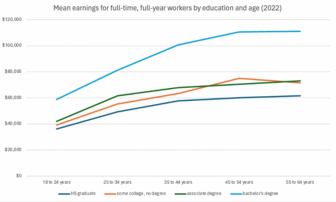Success in today’s and tomorrow’s economy is largely dependent on having a set of skills that are critical in today’s workplace. At Michigan Future, we’ve been using a framework articulated by learning scientists Kathy Hirsh-Pasek and Roberta Golinkoff for these skills, which they define as: collaboration, communication, content, critical thinking, creative innovation, and confidence (the “six Cs“). There are other frameworks around non-cognitive skills or social emotional skills that are also helpful, though we haven’t seen others that combine both these human capacities and content so clearly. Kids equipped with the six Cs are prepared to be adaptive, lifelong learners, able to rebound from challenges, and successful in both postsecondary pursuits and in their careers. Building these skills for all kids needs to be the goal of the education system.
To define these vital skills as the purpose of education, across learning environments, for all kids, does not mean erasing all common content standards. But it does mean that content is no longer the focus to the exclusion of growing other skills. Fortunately, the type of learning environments that foster six C skill development also help kids to integrate their content learning more deeply. Instead of cutting drama to fund literacy tutors, for example, schools with a focus on six Cs will recognize the other skills that drama class nourishes in kids, and may build on the ability of a drama course to shore up weaker literacy skills.
Raising the standard
To reorganize schooling around critical skill building is not a minor tweak to education. It’s a major shift, and it is a raising of the bar as to the purpose of our public education system. It’s a shift: from teacher explains, to teacher facilitates; from defining what kids should know, to how kids should learn; from increasing standardization to increasing adaptability and individuality; from a system that requires teachers to control as much as possible, to a system that asks teacher to empower kids. Most critically, it’s a shift from a filtering system to a system that provides all kids with opportunities for growth.
This shift will of course take resources, but not simply putting money into delivering the same system better or distributing today’s funds more equitably.
On the ground, this shift would entail tens of thousands of Michigan teachers adopting new teaching practices. Districts would have to mandate and support their new approaches. The greater community would need to agree on alignment in the system around skill development as the goal, and the state would need to incent innovation and transformation.
A new type of schooling: what it is
The good news is that there are models for this type of learning, even within the current system. I’ve seen many in action, and while I’d say there isn’t definitive proof that one of these approaches is the most effective or most scalable, I do believe that project-based learning (PBL), inquiry-based education, integrated/thematic instruction, and expeditionary learning seem to have the greatest promise to foster simultaneously deep learning around content and critical skill development. What the schools doing this work tend to have in common, regardless of the pedagogical approach they’ve adopted, are:
- a unity of purpose from leadership on down;
- an emphasis on students having some direction over their learning;
- a recognition that the human brain does not learn in discrete content blocks, so learning is often be more cross-disciplinary than in traditional schooling;
- the pursuit of depth over breadth in understanding;
- a move to performance tasks or assessments to evaluate student learning, rather than standardized testing;
- the presence of strategies that increase student engagement—not simply by adding pop culture to the curriculum, but by asking students to wrestle with meaningful questions about the world and their role in it or to take on projects that have potential impact for others; and
- alignment of the school’s infrastructure to support the purpose—which can involve a rethinking of schedules, classroom arrangements, and collaborative teaching; student cohorting; changes to grading policy, credit requirements, and report cards; and student placement in internships, early college, and in educational settings outside the school building; among many other changes.
In these classrooms and schools, teachers have less control over exactly what material students learn, because they don’t just deliver content through readings, lectures, and homework assignments. Instead, they set up the conditions and experiences for learning and guide students along the path.
I was extremely lucky during my time here to interview a number of the people who are doing leading this work in Michigan–like Danielle Jackson in Detroit, Lisa Bergman and Lisa Diaz in Mt. Pleasant, and Kevin Polston and Carol Lautenbach at Godfrey-Lee–and around the country, like Sarah Fine at High Tech High. If you need some inspiration, and want to know how differently they imagine school, check out these and other What Now? interviews.
What it isn’t
Because in too many education environments I have seen tablets and responsive software explained as innovation, I want to note that in my view, none of the models that foster six C learning are dependent—except in a pandemic—on the use of new technology. Technology in schools should be viewed as a tool, like a chalkboard once was, or a pencil, or a book. Used wisely, technology can help students collaborate, or serve as a vehicle for creative projects, or help students think about communicating their findings. But massive technology upgrades are not the core way we will achieve broad six C learning, which depends much more on well-designed learning experiences and an authentic relationship with an engaged adult. Let’s not be lazy in defining adaptive technology deployment as a stand-in for actually personalized instruction.
Equity demands imagination
Finally, a word about innovation and equity. We know that innovation is vital to achieving educational equity, as our current system is failing to achieve equity at any scale. Yet I have seen first-hand what can happen when innovation is deployed first on poor and Black and brown children: before it has been well-tested, without adequate support (funding), or without any local, or nonwhite leadership. I have seen the utter failure of “innovative” models that were deployed first in a low-income, Black and brown neighborhood. The response by the system to the failure has been additional harm to children (blaming the kids or families and lowering the standard, or closing the school and causing immense disruption). Poor and nonwhite children can’t be guinea pigs, though they are the children who most need us to be innovative because they are the most poorly served by our current system.
While I don’t know exactly what policy changes will bring about the system I’m describing, I do know that in too many conversations, we are constrained by our inability to truly understand today’s reality, by a lack of imagination as to what school could be like, and by a shameful tolerance of the status quo, which so poorly invests in so many children. Today’s reality is marked by inequality and system failure, where harm to children is common. We lack urgency if our kids are in “good enough” schools, even though kids one town over are not. When we try to envision the future, too many of us can only go as far as imagining our favorite teacher from 7th grade. Those excellent teachers may be inspirations, but we have to now ask how to get that kind of learning across the system, in all classrooms, for all of Michigan’s children.
Today is my last day with Michigan Future. I am offering a series of reflections on education in Michigan from my years of work understanding what the future, and the present, will demand of our children. While there have been many others, my most critical learning opportunities have been: our relationships with the school leaders that were a part of Michigan Future Schools; planning, with a series of remarkable educators, the Outsmarting the Robots event, where we tried to model the learning experiences we should be offering to kids; and each of the leaders, educators, and researchers I interviewed during the pandemic for What Now?–our video series on education. You can read my two earlier posts: What I want for Michigan’s children, and How better measures would leave no doubt about the need for school redesign.








